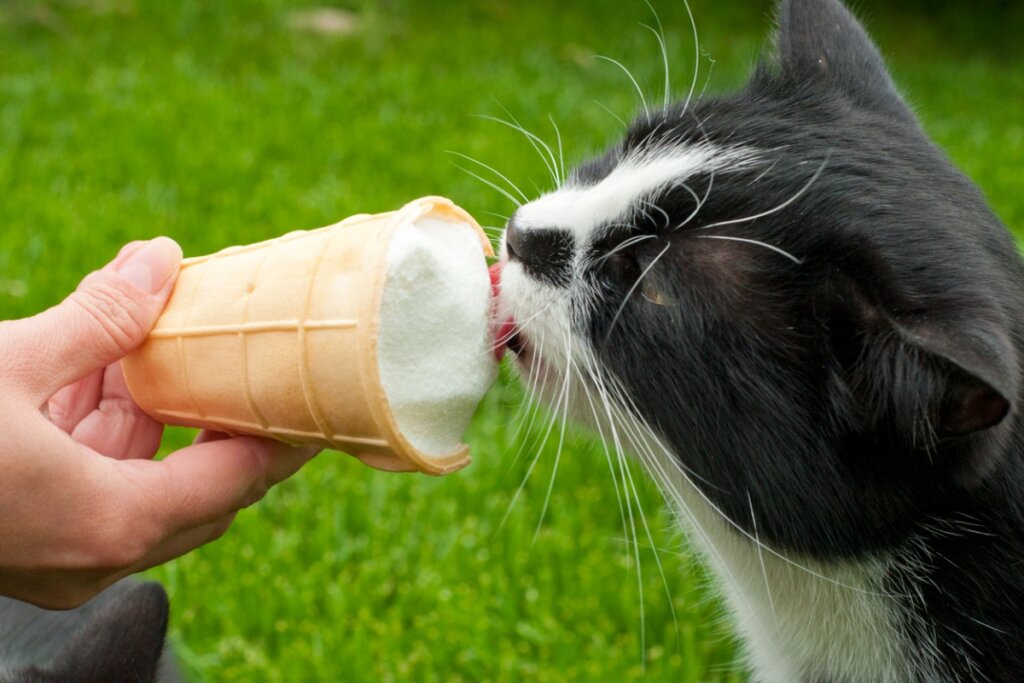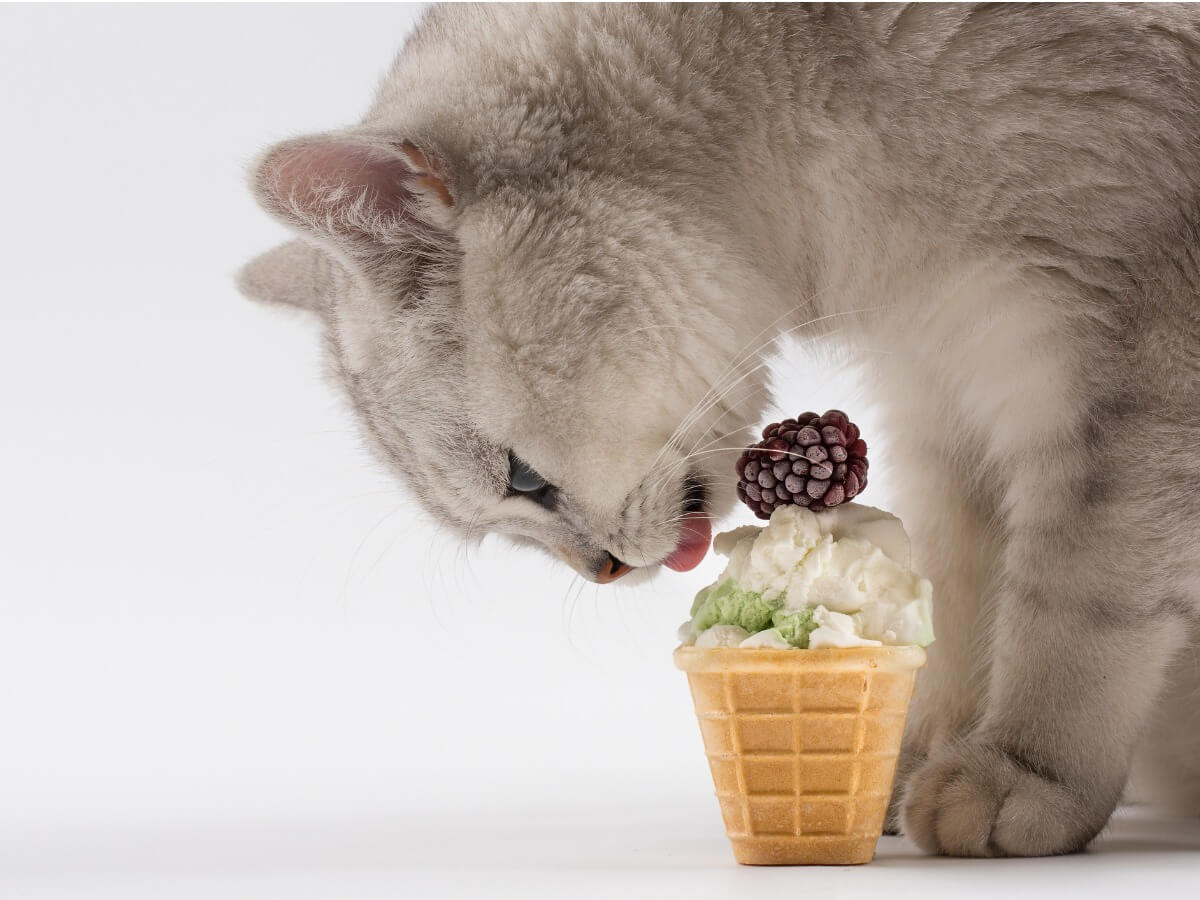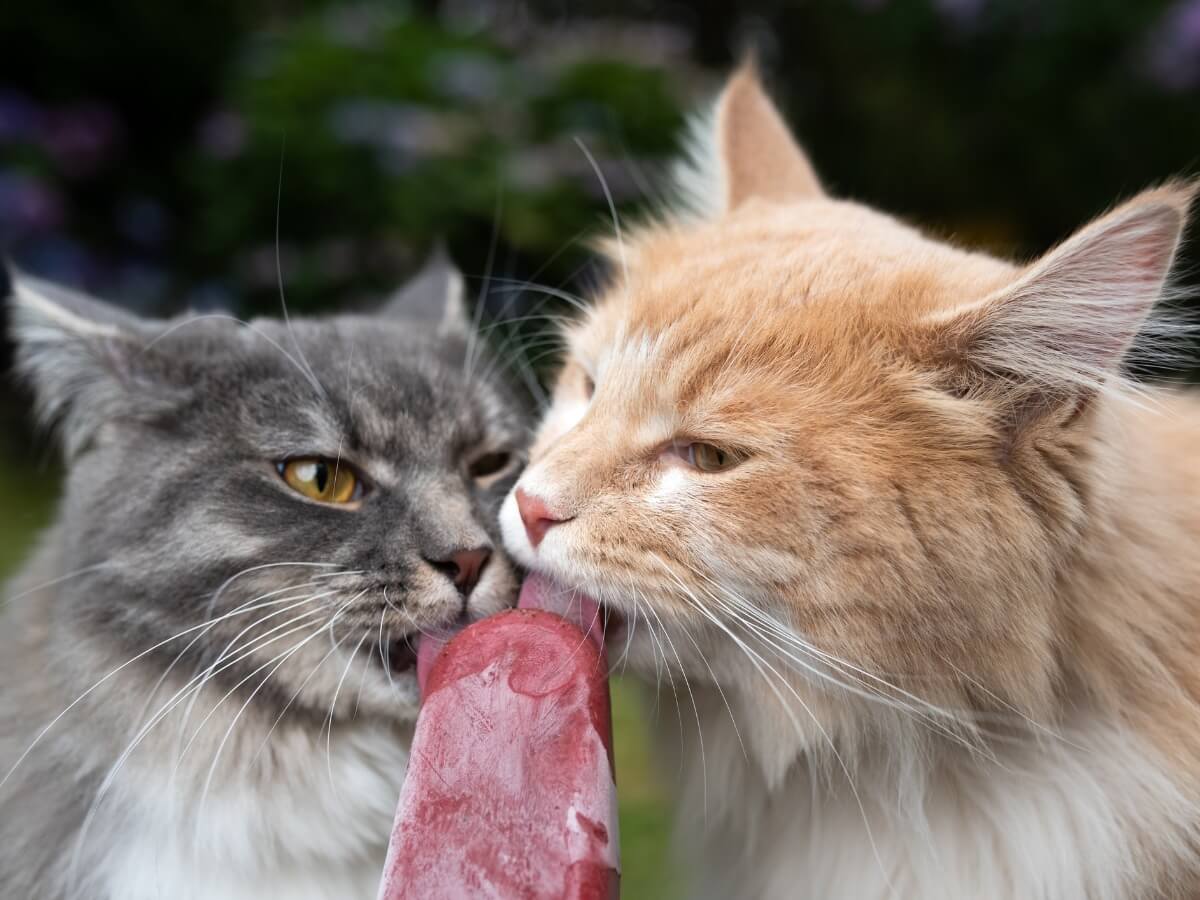Can Cats Eat Ice Cream?

It’s common for guardians to wonder whether cats can eat ice cream during the summer, a time when we, as humans, eat a lot more of this delicacy. Maybe you’ve already given your cat a taste of your ice cream cone or lolly, but, before doing it again, you should know what happens in their delicate body when they eat this type of food.
In this article, we’ll explore, with solid and well-founded arguments, whether or not it’s healthy to feed cats ice cream and, if so, what the appropriate way of serving it is. Keep reading!
Can cats eat ice cream?
The answer is a resounding no. Conventional ice cream made for human consumption has ingredients that are unhealthy for pets. These include milk fats and solids, natural or artificial sweeteners, stabilizers and emulsifiers, fruits, artificial flavors, and water.
With the exception of water, almost all of these ingredients are unsuitable and we shouldn’t let our cats consume them. The main reason is that their bodies aren’t designed to digest them, and so it could cause them some problems.
This is because, as experts explain, cats are strict carnivores, which means that their digestive system isn’t equipped to optimally process foods other than meat in excessive quantities. In the wild, most of their diet is protein and fat of animal origin.

The effects of ice cream on cats
Although it has become normal to let cats eat foods such as ice cream, you must be careful and get to know the effects of this food on their bodies. So, without further ado, we’re going to tell you what the main negative effects of giving our cats ice cream are. Don’t miss it!
They “freeze” the brain
Have you ever eaten ice cream or something very cold that almost seems like it has “frozen” your brain? We’re sure you have, and it probably gave you a headache too. This is a condition often known as cold-stimulus headache – medically known as sphenopalatine ganglioneuralgia.
What happens in the body is that the arteries dilate at great speed, affecting the trigeminal nerve, also known as the fifth cranial nerve. This area is responsible for functions related to the reception of oral and mandibular stimuli, and so the impact is also felt in the mouth, throat, and surrounding nerves.
Well, that sensation of pain and confusion of the senses that humans feel is also experienced by cats when they eat ice cream or other frozen foods. This is a warning not to follow the fads of social networks, where videos of cats eating ice cream have gone viral. For many, the face the cats make is funny, but, in reality, it’s a sign of pain.
It causes digestive disorders
Ice cream for human consumption is made with a large number of ingredients that aren’t tolerated well by a cat’s digestive system. This is the reason why different digestive disorders occur, especially since most felines are lactose intolerant.
Studies explain that cow’s milk has a higher lactose concentration compared to the milk produced by female cats. This means that, when the cat consumes this milk, its body has problems digesting it, giving way to different digestive disorders. This is also related to the high fat content of dairy products.
Among the most frequent digestive problems which may indicate that your cat is lactose intolerant, are the following:
- Mild or chronic diarrhea
- Vomiting
- Abdominal pain
- General discomfort
It can lead to obesity and diabetes
Scientific articles reveal that cats, unlike most mammals, can’t identify sweet food and only have 4 taste dimensions. This can cause the cat to eat more than necessary if it perceives a high level of palatability in the ice cream.
However, feeding cats ice cream frequently and in exaggerated quantities can have repercussions on weight and blood sugar levels, leading to possible obesity and diabetes. This causes many more side effects than a physical change, so it should be avoided at all costs.
On the other hand, it’s necessary to identify what type of sweetener the ice cream has. Xylitol, a sugar substitute that’s used in candies and gum, can induce the pet to a state of hypoglycemia or low blood sugar that can be fatal in the most serious conditions.
Are there ice creams that cats can eat?
Other ingredients in ice cream, and which are toxic to cats, are chocolate, nuts, and coffee, as confirmed by research. So, we can reaffirm that ice cream is not a suitable food for cats.
However, after explaining all of the above, a new question arises: are there ice creams that cats can eat? The answer is yes, because owners can prepare homemade ice creams free of harmful ingredients for their cats. These must be prepared without lactose, sugars, or fats. In exchange, pieces of apple, pear, or papaya fruit can be added.
You can also put vegetables such as carrots and even sources of protein of animal origin such as liver, meat, or chicken. These flavors may not be attractive to humans, but cats will enjoy them a lot, especially in times like summer. In addition to being a good reward, they also provide good nutrients.
To avoid the “frozen brain” effect, we recommend you take the ice creams out of the freezer beforehand so that they’re not so cold. It’s also a good idea to put them in an interactive toy that makes the cat work to obtain the food, as this will stimulate them.

Can cats eat ice cream? Yes and no
In conclusion, we can say that cats can eat ice cream that’s manufactured especially for them, taking into account their nutritional needs. However, they shouldn’t consume conventional products designed for humans, as they can’t properly digest most of the ingredients they contain.
Remember that cats are strictly carnivorous animals, so the basis of their diet should always be protein and fat of animal origin. The rest of the macronutrients should be used with a lot of care and on special occasions.
All cited sources were thoroughly reviewed by our team to ensure their quality, reliability, currency, and validity. The bibliography of this article was considered reliable and of academic or scientific accuracy.
- Pierson, L. La alimentación de su gato: Conozca los fundamentos de nutrición felina. 2013. Disponible en: https://catinfo.org/docs/Spanish.pdf
- Nutrición y alimentación del cachorro en la práctica. Med. Vet. Vol. 7 Noviembre 1990.
- Jeusette, I., Romano, V. El comportamiento alimenticio de los gatos. Disponible en: http://www.affinity-petcare.com/veterinary/sites/default/files/rr_comportamiento_alimenticio_gatos.pdf
- Daza, M., Ayuso, E. Intoxicaciones más frecuentes en pequeños animales. AVEPA. Vol. 24. Núm. 4, 2004.